|
The
photo of a bee sitting upon a flower, licking its nectar, is probably
the most familiar image that we all have of bees.
Only
beekeepers see the bees in the first half of their life, the first three
weeks, when they live and work inside the hive.
Only
then do the bees fly outside the hive, first for two or three days, as
guardians of its entrance, then and for the rest of their life, as
pollen, water and nectar collectors. (This they will transform into
honey with the help of some body fluids)
It
is during this period of about twenty-five days when they become
familiar to us. (Only the bees that reach the end of the harvest season,
at the beginning of the winter, and spend the cold season feeding
themselves with their stocks of pollen and honey, sheltered inside the
hive, without having to use most of their energy, can survive till next
spring, up to six months, all together, at the most).
But
the really most important job that bees do when they sit upon a flower
is not collecting this rich and sweet aliment for us, greedy humans.
Since before we even appeared on Earth, a very large number of plants
have been using these insects as “Cupid”, as messengers in their love
affairs, as a very effective way, sometimes the only way, for their
reproduction, like artificial insemination, so common in our modern
times.
I’m
talking about pollination; the way complete plants (Phanerogams) use the
fecundation of their own seeds for reproduction.
Pollination, passing the pollen produced in the stamen (the masculine
organ of the flower) to the stigma (the female) that receives the
pollen, situated on the top of the pistil, and from there to the
ovaries, where the seeds are fecundated by it) is done by different
forms: Auto-pollination, when everything happens in every single flower
or in different flowers of the same plant, directly without needing any
outside help, or just by the wind (Anemophillas flower). (There is also
pollination by the water, for some kind of grass and aquatic-plants that
works in similar ways).
The
flowers of these types of plants are normally small, insignificant,
without aromas, and they don’t produce nectars or anything that’s
interesting for the majority of insects. Good examples of these plants
are wheat, corn and oats, as well as tobacco and peas and also the oak,
black poplar, linden, elm, walnut and pine trees, among others.
Finally, there is the crossed pollination, pollen from the flowers of a
plant pollinating flowers of other plants of the same species. Those are
the flowers that we all know and appreciate for their colours, aroma and
beauty, the ones that produce nectars to attract and feed a good amount
of small creatures (zoophilla flower), that the plant uses in a perfect
symbiosis to complete its vital circle.
The
crossed pollination of the zoophilla flower is basically done by insects
(entomophilla flower), but also by birds (ornitophilla flower), bats and
other small mammals, even snails and little reptiles.
Among the insects, the bees, the different kinds of honeybees, are
without doubt the most important of them all, the most responsible for
this job, because of their number and how hard they work. The entire
bee-society depends on it; even their own hairy bodies are highly built
up especially for doing this job. Pollen and nectar (honey) is what they
eat and they can’t survive any other way.
Visiting the Hives at “Can Pep Cudulá”
To
speak (I should say to listen and learn about pollination and about bees
in general, Gary and I went in March, the beginning of our spring, about
two weeks before the official date of the real spring, the bee-season,
to visit one of the best beekeepers of the Island and also a good
friend, José Planells “Pep Cudulá”, who lives and keeps some of his
hives in his finca, near Sant Llorenç. (Gary wanted to take photos of
the groundwork with the bees, of the interior of a real hive and of the
work of the beekeepers collecting the swarms, preparing the new panels
for the new season and replacing the old honey-panels)
As
our conversation started about the priceless job that bees do in the
pollination of plants and the enormous benefit that this means, not just
for the plants, but to humans and life in general, Pep Cudulá says with
his good manners and tranquil voice: “Perhaps we will never reach to
understand and appreciate what this little insect has really done and
still does for evolution of life and the progress of the human kind”.
Then
I asked him to clear up why bees are so efficient doing this job. How,
if they fly all over, from plant to plant and from flower to flower can
they be so precise? Why there are not many accidents in the crossing
pollination?
“Once the bees start to collect the nectar and pollen from a specific
kind of flower, normally one of the most plentiful in the area at a
certain time of the year, they continue with the same flower until the
harvest is completed and the honey panels are full”.
“There are some accidents sometimes, for example if you have a field
planted with sweet peppers, and there are near by some plants of
hot-peppers (chiles), because they are the same family of plants, soon
you will have a mixture of hot and sweet peppers, even in the same
plant, this can give you a hot surprise sometimes, specially when you
mean to eat a salad or any other dish made with sweet peppers, this can
happen as well with different kinds of melons and cucumbers, also it is
easy to find bitter almonds in what is supposed to be a sweet almond
tree, but some of these accidents are even profitable and help to form
new varieties. This only happens between plants of the same families and
in general, we can say that bees are far more precise then man as far as
knowing different plants and flowers.
“So
we can also speak of different kinds of honey, depending on which type
of plants the bees have been visiting. The difference in the colour,
aroma, thickness and taste are obvious if you can see and taste them one
by the side of the other, even for the non-experts.
“Most of the honey that we buy in jars at the shops is a mixture of
different types mixed by the industrial experts looking for a specific
quality and homogeneity, as it happens for example with coffee and some
wines. But here, as we don’t produce in industrial ways, our honeys are
all different and we call them by the name of the plant, “rosemary
honey”, “thyme honey”, “azahar honey” (azahar is Spanish for the
orange-tree flower and its aroma. I don’t know if there is an English
word for it). My favourite is the carob-tree-flower honey. I was
honoured with the second prize presenting this type of honey in the
first and only honey show in our Islands.
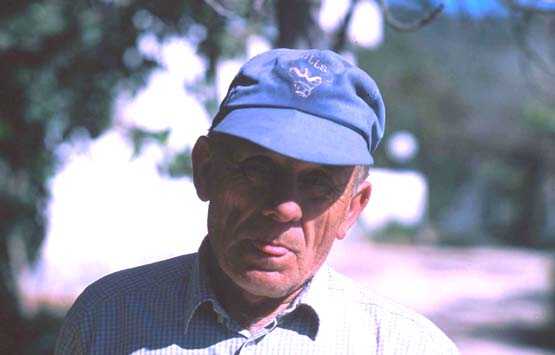
Pep Codulá
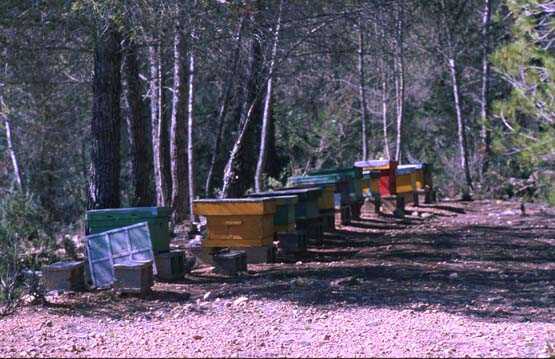
Bee Hives at Can Pep Codulá
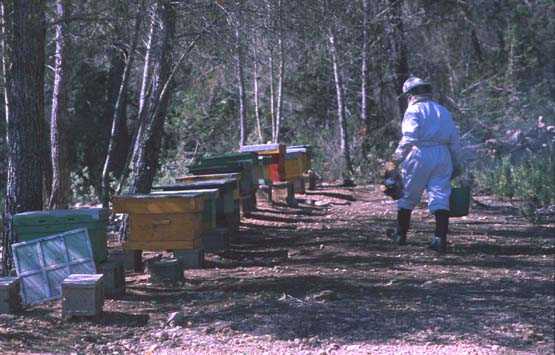
Pep Codulá on his way to attend the bees
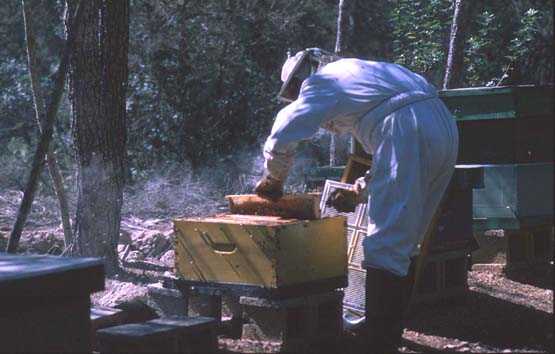
Pep Codulá
checking the honey
|
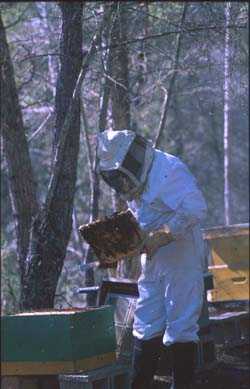
Pep Codulá
amongst his bees
|
|
|
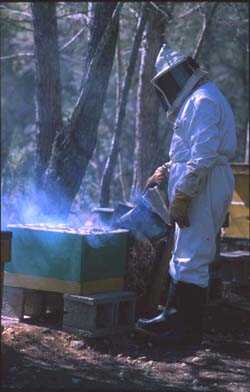
Pep Codulá
smoking the bees
|
|
All Pictures © Copyright
Gary Hardy (March 2002)
We
shall continue for another week of two with Pep Cudulá and his deep
knowledge about bees and interesting practical lessons about Nature in
general. |